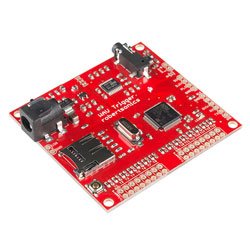The WAV Trigger vs. MP3 players
I'm a little baffled.
The MP3 Trigger has been out at least 5 years now, and it's been a great product. In that time, however, many similar solutions have been introduced - all based on the VLSI MP3 decoder. Indeed, if you're willing to spend time writing code and experimenting with Arduino libraries, you can get pretty close to the functionality of the MP3 Trigger for less money. And with the advent CPU's faster than the lowly 8-bit PSoC, you can probably even get higher bit-rate audio. While the MP3 Trigger still may make sense if you want a practically zero-effort MP3 player solution, the truth is that there are lots of ways to play single MP3 tracks from a microSD card available today.
The problem with all VLSI-based MP3 players is that because the VLSI device is a hardware decoder, it can only process a single MP3 stream at a time. Translation: you can only play one track at a time. If you want to play a second track, you first have to stop the first. You can't even crossfade, cause that would require playing two tracks during the overlap.
Another big problem with all MP3 player solutions is audio compression! The only reason to compress is if you have limited memory or a small pipe. With microSD cards, neither is an issue. And the overhead of decompression is a pain, requiring special hardware (VLSI) or software, as well as a license. And as soon as you want to mix even two MP3 tracks, it gets complicated fast.
Now there's the WAV Trigger. As far as I know, there is currently nothing else like it out there. It's the same size and price as the MP3 Trigger, but blows it (and all other VLSI MP3 players) away in terms of capability. With the most recent firmware update, it supports up to 14 simultaneous uncompressed CD quality (16-bit, 44.1kHz, stereo) tracks, with trigger latency clocking in at around 8 msecs. It has built-in support for individual track volumes, smooth fade-ins, fade-outs and cross-fades, and the ability to start and play 14 tracks in perfect sample sync. In addition to a much richer serial control protocol, its trigger inputs can be individually programmed for active high or low, level or edge triggered, contact closure or logic level control. It has a true line-level stereo output and an on-board 2W mono amp to drive a speaker directly. It has a cross-platform utility to create and generate the init file used to set many programmable options. And the serial interface even supports MIDI, enabling the WAV Trigger to be a true 14-voice polyphonic sampling instrument.
I fully anticipated that sales of the WAV Trigger would cut into those of the MP3 Trigger. Why would anyone purchase the MP3 Trigger when they could get the WAV Trigger for the same price? Other than play an MP3 track, there's nothing an MP3 Trigger can do that the WAV Trigger can't do better, and the WAV Trigger can do so many more things.
Yet evidently, the MP3 Trigger continues to outsell the WAV Trigger by a significant margin. I can only assume it's that people either don't yet know about the WAV Trigger or don't really understand what it's capable of. Or perhaps they just don't need it. Maybe I misread what people are doing with embedded audio players. It's true that you have to convert MP3 audio files to wav files, and maybe that throws people if they just want to grab MP3 files off the web and copy them to a flash card.
In any event, I hope this changes. With the power of an ARM Cortex-M4 available, there are lots of features still to add to the WAV Trigger. But the practical thing to do is to wait and see if people want it first.

